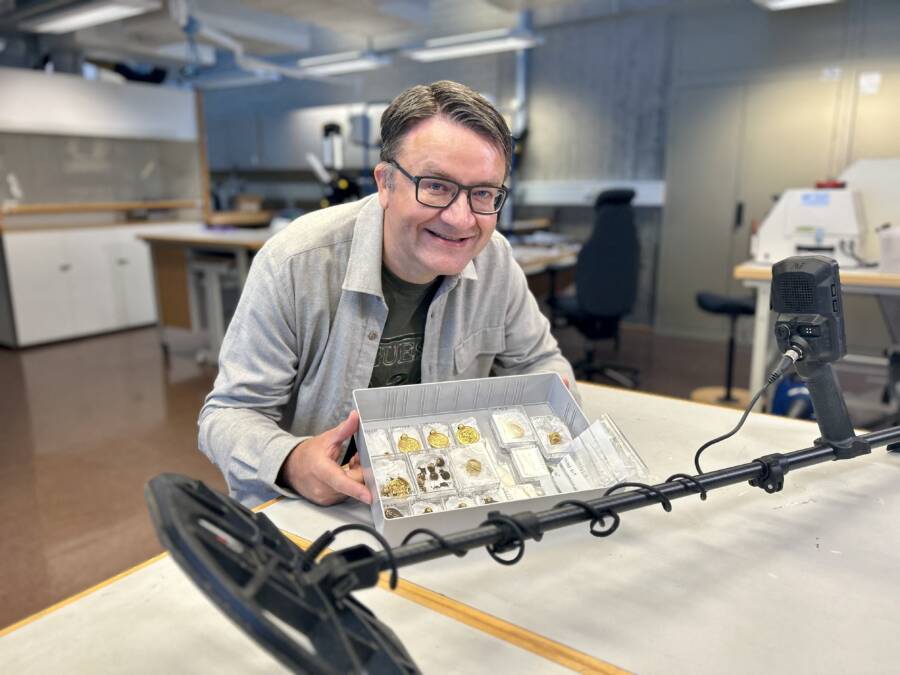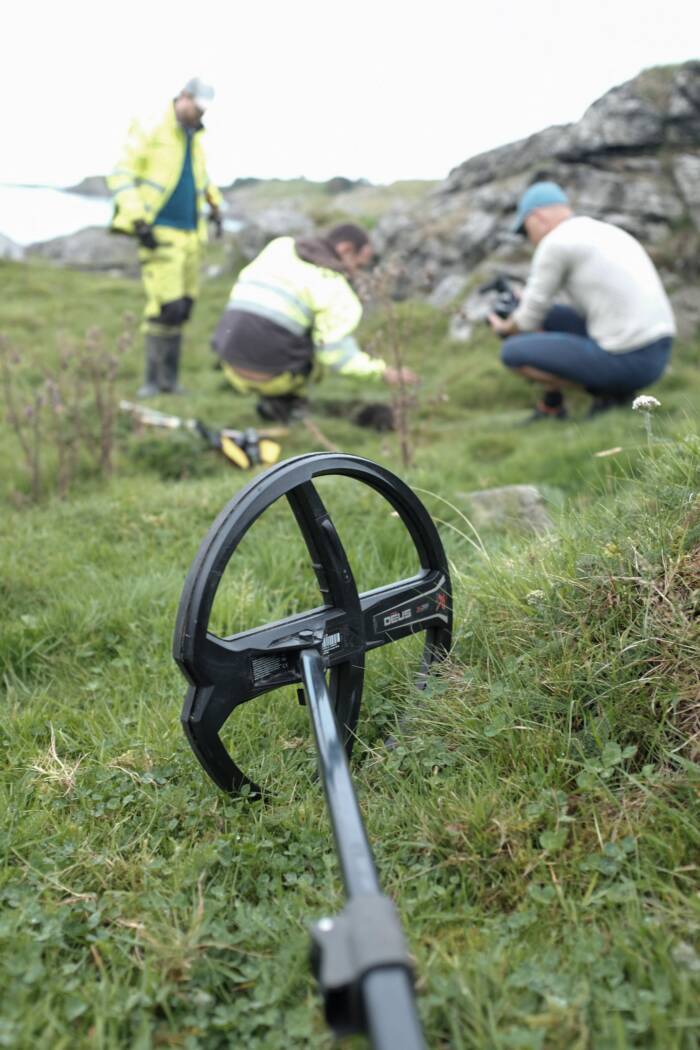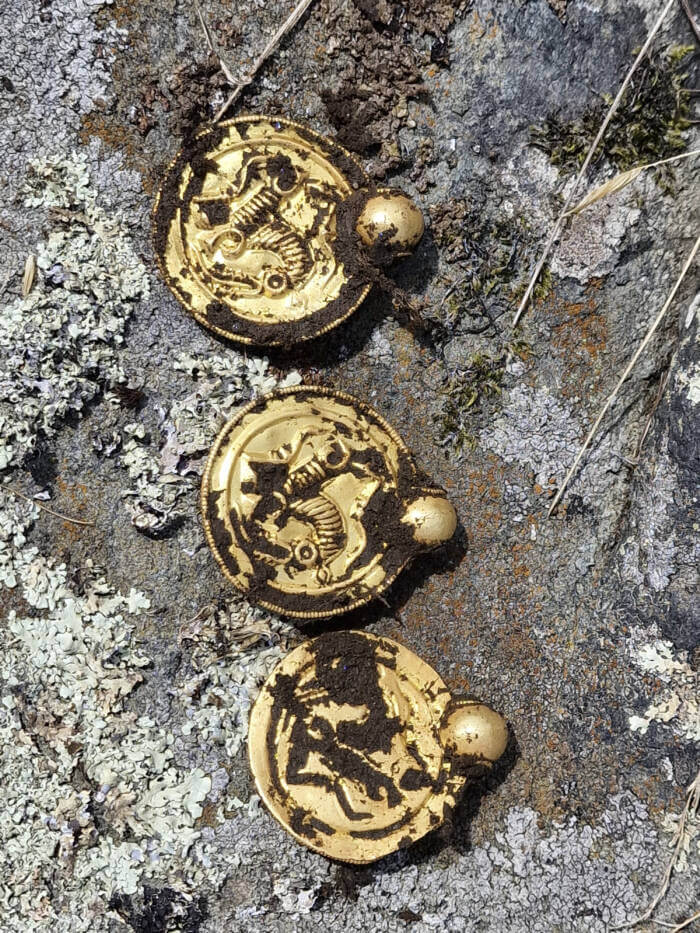The various gold objects date back to around 400 to 550 C.E. and likely belonged to someone in the social elite.
X ( Formerly Twitter)Erlend Bore perplex with the cache of gold he discovered while walking with his metal sensor .
Per his Dr. ’s orders , 51 - year - one-time Erlend Bore was out on a walk near his home on the island of Rennesøy , Norway . He had brought his metal demodulator with him , which he purchased earlier in the summertime to have a Falco subbuteo that would get him out of the house . When the twist react to something in the soil , Bore thought it may have been chocolate money , base on its appearance .
What he had actually found , however , was a memory cache of nine gold pendants , three Au rings , and 10 gold pearls that once mold a meretricious necklace around 1,500 eld ago . Now , experts are calling the discovery the “ golden find of the century . ”

X (Formerly Twitter)Erlend Bore posing with the cache of gold he discovered while walking with his metal detector.
“ At first I think it was chocolate coin or Captain Sabertooth coin , ” Bore toldThe Guardian , advert to a fictitious Norse pirate . “ It was totally unreal . ”
The breakthrough was a dream occur true for Bore , who had dream of becoming an archaeologist as a fry . More amazingly , he was new to the hobby of metal sleuthing , having just purchased his alloy detector in August after his doctor urge he get more exercise .
Bore had late begin take veritable walks on the cragged island , bringing his metal detector along with him . On one such walking , he was just getting ready to call it a daytime and return home when suddenly the machine start claxon on a hillside .

X (Formerly Twitter)Archaeologists from the Stavanger Museum digging up the cache of gold objects.
Bore contacted local archaeologists , who finally dug up the atomic number 79 cache .
X ( Formerly Twitter)Archaeologists from the Stavanger Museum dig up the stash of golden object .
Ole Madsen , head of the University of Stavanger ’s Museum of Archaeology , said it was “ the aureate find of the century in Norway . To find that much gold all at once is extremely strange . ”

X (Formerly Twitter)The recovered medallions featuring a horse from Norse mythology.
harmonise to Norwegian jurisprudence , Bore was not allowed to keep the coin he key out . Under the law , any objects from before 1537 , and coins older than 1650 , are consider Department of State attribute and must be turn over in . On the bright side , both Bore and the property owner will get an award for the breakthrough , though the sum has yet to be determined .
As for the gold detail themselves , they were examined by several professional at the Stavanger Museum . Associate professor Håkon Reiersen found that the Au chandelier were flat , flimsy , one - sided amber medals known as bracteates and date back to between 400 and 550 C.E. , a time refer to as the “ migration period ” in Norway due to the widespread migration happening all across Europe .
Reiersen aver the chandelier and amber pearls were likely part of “ a very showy necklace ” made by skilled craftsmen for the societal elite group .
X ( Formerly Twitter)The recovered medallions featuring a cavalry from Norse mythology .
“ give the locating of the discovery and what we recognise from other alike find , this is plausibly a matter of either hidden valuables or an offering to the gods during dramatic times , ” he say , adding that “ in Norway , no like discovery has been made since the nineteenth C , and it is also a very unusual discovery in a Scandanavian context . ”
Per theAssociated Press , Professor Sigmund Oehrl , an expert on such pendants who also figure out at the Stavenger Museum , said that roughly 1,000 golden bracteates have been found in Norway , Sweden , and Denmark .
The medallions also feature an strange intent depicting a character of horse cavalry from Norse mythology . Oehrl explained that typically , symbols on these pendants show Odin , the idol of war , healing the sick horse of one of his sons . Notably , however , Oehrl said the horse cavalry ’s tongue on the Rennesøy pendant pay heed out and “ its slumped attitude and twisted legs show that it is injured . ”
“ The horse symbolisation comprise unwellness and hurt , but at the same clip hope for healing and new lifespan , ” he tot .
The Archaeological Museum in Stavanger project to put the breakthrough out on video display .
After reading about this awing discovery , scan about the time a woman corrupt cheap costume jewelry online — and founda gold Viking ring in the mixture . Or , read about the 10 - year - quondam whofound an eighteenth - century sword with a metal demodulator he had just have for his birthday .